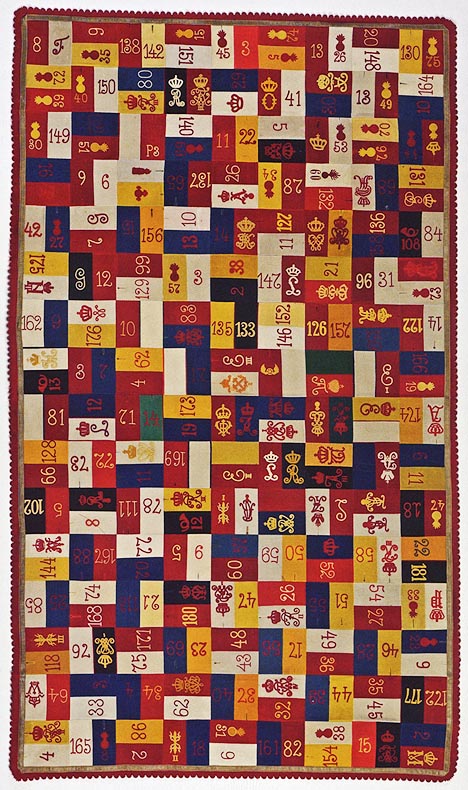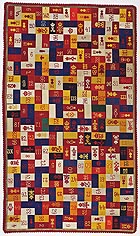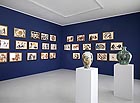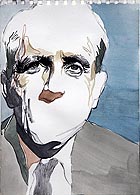
translated and summarized by: Liz Wollner-Grandville,
English summary November 30 - December 6
Österreichisches Museum für Volkskunde: Cloth intarsia in Europe from 1500 until today
Cloth is a special fabric
These objects have something dizzyingly fascinating. Contradicting perceptions and thoughts regarding the recognition of the textile phenomenon contest each other: ingenious handicraft! (How does this actually work?); meticulously merged as an entirety; time – how long does sewing such a piece of art take? – Opulent ornaments, Op-Art back then?! (in the mid 19th century); Flower Power of the old days; pigeons, stags, deer, lions; people in any situation. Dutifully organized, naively stylized, seemingly classical, zealous, and then again surprisingly “modern”, successfully composed, optically pleasing topics of the Christian religion dominate the oldest works, otherwise you will see many military topics – ranging from the Turks to horseback riders or an entire regiment of hundreds of epaulettes from no longer needed uniforms. This is not the kingdom of fine shades; contrasts are far more important. This is what the technique requires: field for field, detail for detail, part for part are positioned, often in a mirror technique, others like an inlaid work, precisely: intarsia.
Although the oldest preserved pieces are more than 500 years old, they are like a new discovery. Given that they showed up here and there and were never categorized this is not really surprising. They emerge in the most diverse contexts; originate in monasteries, in a grand or bourgeois environment, as well as in the regionally traditional culture. Even the naming diverges greatly: in German-speaking countries they go by quilt or “rag-work” or even cloth mosaic; in English from inlaid patchwork, or “clothograph”, in Sweden by intarsia stitching. In a more scientific context the decision was made to denote these artworks as cloth intarsia. Intarsia describes both the actual work and underlines the preciousness, and mosaic also makes sense, but “cloth”?
Cloth really has something ambiguous about the way it is used in cloth intarsia. This cloth takes an exceptional position: woollen cloths are fabrics that are firm on account of a special and elaborate technique. They do not fray and can be sewn together without an extra seam. Woollen cloths were extremely resistant and very expensive. This made them useful for uniforms, which used to be very colourful in the old days. The latter made it advisable to use the material sparingly. A direct result was that woollen cloth was often mended and only after such a piece of clothing had reached the end of its lifecycle would it be used for cloth intarsia. Maybe it is this esteem in its processing that constituted part of the aura these works radiated. The more closely one zooms onto these pieces, the more clearly one can see that these were really leftovers. Even the single-coloured parts were pieced and held together with thousands of stitches. Two years ago, Sotheby’s auctioned one of these patchwork pieces (1.5 m2) for 30.000 pounds.
Detailed research of cloth intarsia commenced in the 1980’s following the restoration of one piece, which was part of the Collection of the German Ethnology in Berlin. At first one searched for comparable objects and found that many museums and collections had similar textiles, but usually only as unique (and rather unheeded) pieces. 70 of these objects were put together in a catalogue and extensively described. 30 originals can now be viewed, or experienced, in a first presentation at the Austrian Museum for Ethnology.
By Aurelia Jurtschitsch
Österreichisches Museum für Volkskunde
1080 Vienna, Laudongasse 15-19, until 14.03.10
www.volkskundemuseum.at
Burger Collection: Conflicting Tales: Subjectivity
Subtle debut
Bastian, Boros, Burger – what appears to be a short excerpt from a German telephone book, is actually the illustrious list of collectors that have recently opened a subsidiary in Berlin: Heiner Bastian in a Chipperfield building alongside the renovated Neue Museum, Christian Boros in an art-bunker topped by a penthouse close to the Deutsches Theater, and Monique Burger at the former premises of Arndt & Partner on Zimmerstrasse. Burger employed the same tasteful discretion with which she chose her Berlin address for the development of her comprehensive collection of more than 1,000 artworks. She doesn’t only focus on fashionable and marketable investment-art, but also on quieter and more difficult works by young unknown artists. The Berlin-debut is only the starting point of a four-part exhibition cycle, which is also headed towards Brussels, Mumbai, and Hong Kong, and is accompanied by a tight schedule of events including lectures, artist- and roundtable discussions as well as symposiums.
The forced intellectual claim is asserted through the motto under which the first part of the tetralogy is set: subjectivity. Curator Daniel Kurjakovic successfully stages fruitful confrontations: be it by juxtaposing the work of the Pakistani artist (and former pathologist) Nalini Malani “Listening to the Shades”, which attempts to merge myth and medicine, with the figurative vase paintings of Turner Prize-winner Grayson Perry or when Muntean/Rosenblum together with Collier Schnorr contemplate the contribution of poses and gestures for the creation of a subject, or if a painting by Norbert Bisky, the Grisaille paintings by Rafal Bujnowski and the drawings by Douglas Kolk are joined, visualizing the dangers of (foremost physically) growing up.
In the meantime, the Burger Collection itself is relieved of such adolescent antics. It seems to be in great shape and, with this exhibition, its social debut was definitely successful.
By Peter Kunitzky
Burger Collection
10117 Berlin, Zimmerstrasse 90/91, until 13.12.09
www.burgercollection.org
Startgalerie im Museum auf Abruf: Philip Patkowitsch – Somewhere North to the Future
Don’t I know him?
That’s the question that automatically comes to your mind while viewing the numerous small-format aquarelles painted by Philip Patkowitsch, which are currently displayed in the exhibition “Somewhere North to the Future”. They are portraits of men that at the same time seem familiar and as if they were strangers. One assumes to have recognized Clint Eastwood or Albert Einstein, but one is never sure if these acquainted and seemingly significant faces might, if one could see them in their entirety, be completely unknown. This is the charm of these partially collaged aquarelles: they show an incomplete or awkwardly distorted face and despite their technical quality are never true to life depictions. Typical for Patkowitsch’s technique is that the works are more sketchy and rather subdued in their colourfulness but expressive in their gestures and focus masterfully on significant details. He skilfully plays with collective reminiscences, with the cultural memory of a society - and then breaks these stereotypes up to unmask their meaninglessness. For instance when we view a workingman’s lower body, his arm, and the hand which is obviously not holding a tool, and therefore conducting a “void motion”.
A completely different, but nevertheless harmonious supplement is “found woodage”: large drawings on canvas, all showing heaps of wood. These are skilful abstract compositions that let one guess what they actually constitute.
Common to both parts of the exhibit is the aura of the “has-been”, the old, the no longer belonging to the present: such as the ink drawings showing dilapidated or collapsed wooden constructions or the portraits reminding of stars and personalities of the 1950’s or 1960’s.
By Wolfgang Pichler
Startgalerie im Museum auf Abruf
1010 Vienna, Felderstrasse 6-8, next to the Town Hall, until 10.12.09
www.musa.at/startgalerie
Kunsthalle Wien: Videorama – Artclips from Austria
(Videonation) Rescued!
As the title implies, Videorama is exclusively devoted to art videos, and shows Austrian productions created during the last ten years, which will be presented around the world. The overproduction of art, and especially the excess of videos, can – for some viewers – create a feeling of audiovisual horror.
The exhibition opens with a static animation of a burning candle, an image rich with historic reminiscences, which refers both to the tacit art of painting as well as the Sonic-Youth album “Daydream Nation”; it is both a camouflage and a decoy for outsiders. The usual depressive darkness of a video chamber is no longer state-of-the-art at this exhibition. Contemplation instead of isolation is choreographed in a diversified ambience, split into six different topics. Through simultaneous viewing and comparing of numerous video clips on the basis of orchestral relations between image, sound, and text, the aim is to make ones own conclusions about the “Society of Monitors”. In addition, tiny monitors inform on how long the film is still going on and which exciting “meta scenarios” are to be expected.
The exhibition starts with everyday cabaret-like public activities and performances by young Austrian artists, which can be viewed as documentations on small screens, and ends with a night projection showing a number of snow caterpillars in a winter Alpine landscape undertaking their both useful and useless tasks. Intermediately, clips, which create artificial as well as real fear or transform the surrealistic narrative, may also be viewed. This mixture of “Artclips from Austria” offers an opportunity to take a closer look at contemporary artistic overproduction: we tend to only remember the handful of outstanding artists, because we forget that they are surrounded by countless others. And what does not distinguish the individual might be formed by the mass.
By Goschka Gawlik
Kunsthalle Wien
1070 Vienna, Museumsplatz 1, until 10.01.10
www.kunsthallewien.at
Mehr Texte von translated and summarized by: Liz Wollner-Grandville


 Teilen
Teilen





